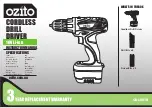
8
Switch action (Fig. 3 & 4)
CAUTION:
• Before inserting the battery cartridge into the tool,
always check to see that the switch trigger actuates
properly and returns to the “OFF” position when
released.
• When not operating the tool, depress the lock-off but-
ton from A side to lock the switch trigger in the OFF
position.
To prevent the switch trigger from accidentally pulled, the
lock-off button is provided.
To start the tool, depress the lock-off button from B side
and pull the switch trigger.
Tool speed is increased by increasing pressure on the
switch trigger. Release the switch trigger to stop. After
use, always press in the lock-off button from A side.
Lighting up the lamps
CAUTION:
• Do not look in the light or see the source of light
directly.
To turn on the lamp, pull the trigger. Release the trigger
to turn it off.
NOTE:
• Use a dry cloth to wipe the dirt off the lens of lamp. Be
careful not to scratch the lens of lamp, or it may lower
the illumination.
ASSEMBLY
CAUTION:
• Always be sure that the tool is switched off and the bat-
tery cartridge is removed before carrying out any work
on the tool.
Installing or removing saw blade
CAUTION:
• Always clean out all chips or foreign matter adhering to
the blade and/or blade holder. Failure to do so may
cause insufficient tightening of the blade, resulting in a
serious injury.
• Do not touch the blade or the workpiece immediately
after operation; they may be extremely hot and could
burn your skin.
• Tighten the saw blade securely. Failure to do so may
cause a serious injury.
• When you remove the saw blade, be careful not to hurt
your fingers with the top of the blade or the tips of work-
piece.
To install the blade, open the tool opener to the position
shown in the figure.
(Fig. 5)
Keeping that situation, insert the saw blade into the blade
clamp as far as the two protrusions of the blade can not
be seen.
(Fig. 6)
Return the tool opener to its original position.
After installing, always make sure that the blade is
securely held in place by trying to pull it out.
CAUTION:
• Do not open the tool opener excessively, or it may
cause tool damage.
To remove the blade, open the tool opener to the position
shown in the figure.
(Fig. 7)
Pull the saw blade out
toward the base.
NOTE:
• Occasionally lubricate the roller.
Hex wrench storage (Fig. 8)
When not in use, store the hex wrench as shown in the
figure to keep it from being lost.
Cover plate (Fig. 9)
Use the cover plate when cutting decorative veneers,
plastics, etc. It protects sensitive or delicate surfaces
from damage. Fit it on the back of the tool base.
Anti-splintering device (Fig. 10)
For splinter-free cuts, the anti-splintering device can be
used. To install the anti-splintering device, move the tool
base all the way forward and fit it from the back of tool
base. When you use the cover plate, install the anti-splin-
tering device onto the cover plate.
CAUTION:
• The anti-splintering device cannot be used when mak-
ing bevel cuts.
Dust extraction
The dust nozzle (optional accessory) is recommended to
perform clean cutting operations.
(Fig. 11)
To attach the dust nozzle on the tool, insert the hook of
dust nozzle into the hole in the base.
The dust nozzle can be installed on either left or right
side of the base.
(Fig. 12)
Then connect a Makita vacuum cleaner to the dust noz-
zle.
(Fig. 13)
OPERATION
CAUTION:
• Always hold the base flush with the workpiece. Failure
to do so may cause blade breakage, resulting in a seri-
ous injury.
(Fig. 14)
Turn the tool on without the blade making any contact
and wait until the blade attains full speed. Then rest the
base flat on the workpiece and gently move the tool for-
ward along the previously marked cutting line.
NOTE:
• If the tool is operated continuously until the battery car-
tridge has discharged, allow the tool to rest for 15 min-
utes before proceeding with a fresh battery.
When cutting curves, advance the tool very slowly.
Bevel cutting (Fig. 15)
CAUTION:
• Always be sure that the tool is switched off and the bat-
tery cartridge is removed before tilting the base.
With the base tilted, you can make bevel cuts at any
angle between 0° and 45° (left or right).
Loosen the bolt on the back of the base with the hex
wrench. Move the base so that the bolt is positioned in
the center of the bevel slot in the base.
(Fig. 16)
Tilt the base until the desired bevel angle is obtained.
The V-notch of the gear housing indicates the bevel
angle by graduations. Then tighten the bolt firmly to
secure the base.
(Fig. 17)
Front flush cuts
Loosen the bolt on the back of the base with the hex
wrench and slide the base all the way back. Then tighten
the bolt to secure the tool base.
(Fig. 18)









































